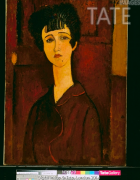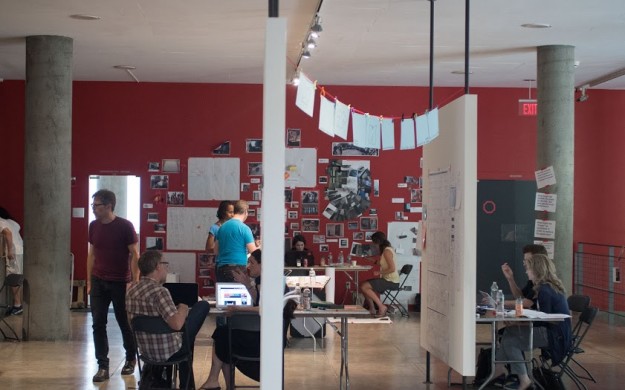Beautiful Data II at Harvard metaLAB
Over the summer I had the pleasure of attending a workshop at Harvard, sponsored by the Getty Foundation. Beautiful Data II, hosted by the Harvard metaLAB, brought together artists, art historians, museum professionals, scholars of visual culture, and me (a lawyer) for a two-week workshop. The workshop explored “difficult collections”, as well as how they are engaged by technology and are challenged by the tensions between digital and material. After all, not everything in a collection lends itself to digitization. The workshop also focused not only on how on data generated by digitization might inform collections and curatorial decisions, but also on how data, itself, could be used as a medium for art.
Originally, I thought the workshop would primarily benefit me through the observations that would inform my research and the new relationships with which I would leave. I was surrounded by people who were passionate about visual culture and digital heritage, all of whom had developed impressive careers and were making important contributions in their fields. What I had not expected was to find the workshop so relevant and influential to my own problem collection.
On the first day we each introduced our problem collections to the group. Mine? Surrogacy. It turned out others were considering this issue too, albeit it was described differently and contextualized within their own respective fields of art history, museum studies, or academic scholarship. Everyone seemed to have a personal story about how copyright and surrogate rights impacted their archival practices, online presence, and public missions. In fact, two metaLAB team members, Sarah Newman and Kyle Parry, explored the specific question of the digital image as the object’s surrogate and exploring where the object begins and ends.
The first week of the workshop was largely educational: during the day we attended short, inspiring lectures, flash-talks from participants presenting their work and problem collections, and break-out workshops in which we applied our discussions through thought-provoking exercises.
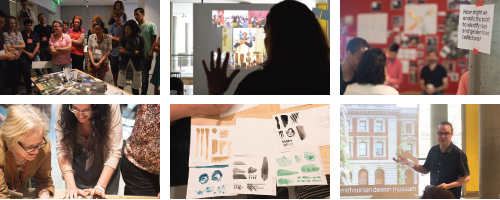
Photo credits: Harvard metaLAB team
During this week we explored questions like:
- How can we make things that others can hack and use?
- How might we use data and media to uncover unexpected relationships between objects and social issues?
- Should museums strive to provide better access to information for visitors?
- Can we invent ways for audiences to experience art in a more sensory way?
- When is technology the answer?
- How does materiality change the way we think about various things like pigments and color?
- How many images should appear on a website and of what type? What about copyright issues; how are those addressed?
The second week of the workshop was dedicated to prototyping out platforms for exploring these questions and designing approaches toward managing problem collections. We were encouraged to work as a group or individually if more appropriate. The workshop concluded with a day of project presentations.
Surrogacy as a Problem Collection
Instead of working with a group, I decided to use this opportunity to tackle surrogacy. There was no better group of people to provide interdisciplinary, substantive feedback, and I already had the data ready to go. Without further ado, let me introduce you to my massive surrogate rights excel sheet:
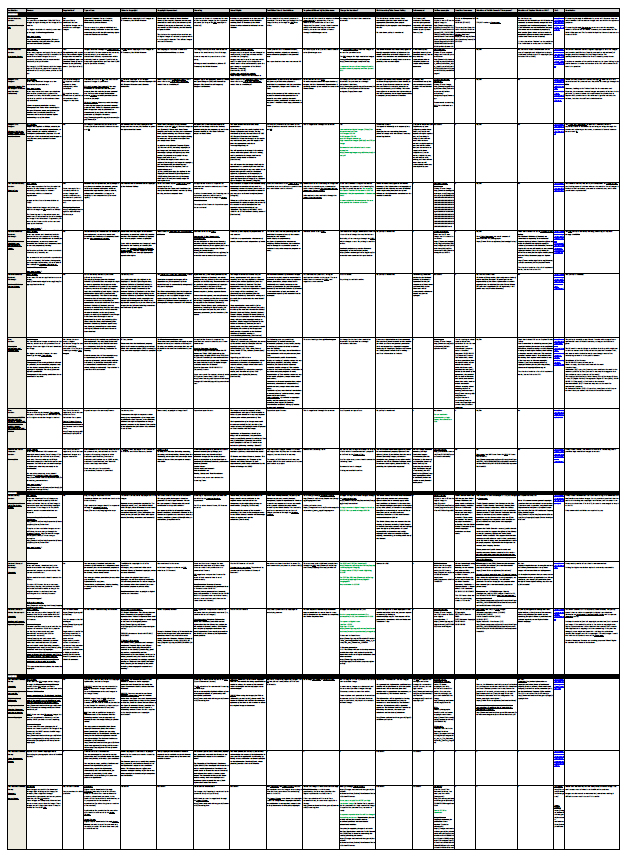
I know what you’re thinking, and you’re right. It’s not readable. So you’ll just have to trust me when I tell you that it includes raw and meticulously extracted data, as well as information that I’ve processed after poring through various pages on an institution’s website. It also includes only cultural institutions of national significance in the United Kingdom, and it’s even missing a few. But, as it is, the chart was so large that it became difficult to navigate and update, nor was it transcribed in a form that might be useful for individuals without a legal background. This divide between legal scholarship and public communication is a common issue for public education and impact. I decided to explore how I could take this complicated issue of surrogacy and present it to the public in an understandable way: by creating a website that clarifies cultural institutions’ online terms and conditions. The website would aggregate and translate all of the relevant information to the public to inform them what they could and couldn’t do with images of works in a cultural institution’s collection, specifically images of works in the public domain.
In order to better analyze the data, I printed off the spreadsheet (for the very first time):
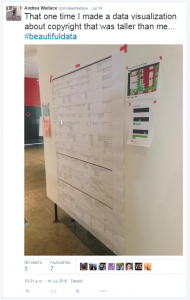 For the record, I’m 5’9”. So, yes, this chart was a doozy.
For the record, I’m 5’9”. So, yes, this chart was a doozy.
Next, I made a list of common questions that all users might ask, such as:
Can I take my own images during a visit?
Can I post those images on social media?
Can I download images from the institution’s website?
Can I sell things that I make using the downloaded images?
Can I pay for permission for extra use?
Can I find this institution’s content online anywhere for free?
(and so on…)
Finally, I set out my goals for the website’s functionality. First, I wanted to focus on literacy: the website would have a readable, interactive chart presenting my research in a usable manner. Second, I wanted to focus on transparency: the website would translate the various terms and conditions drafted for cultural institutions, which are usually contained in a number of pages on the websites, into understandable, clear policies. Finally, I wanted to focus on history: a final part of the website would track and archive institutional policies as they changed over time.
And, now, what to name the website? Drum roll, please…
Introducing “Copy That”
Lucky for me, I’m a graphic designer, so I could design the majority of the content. For example, that big old crazy spreadsheet became this:
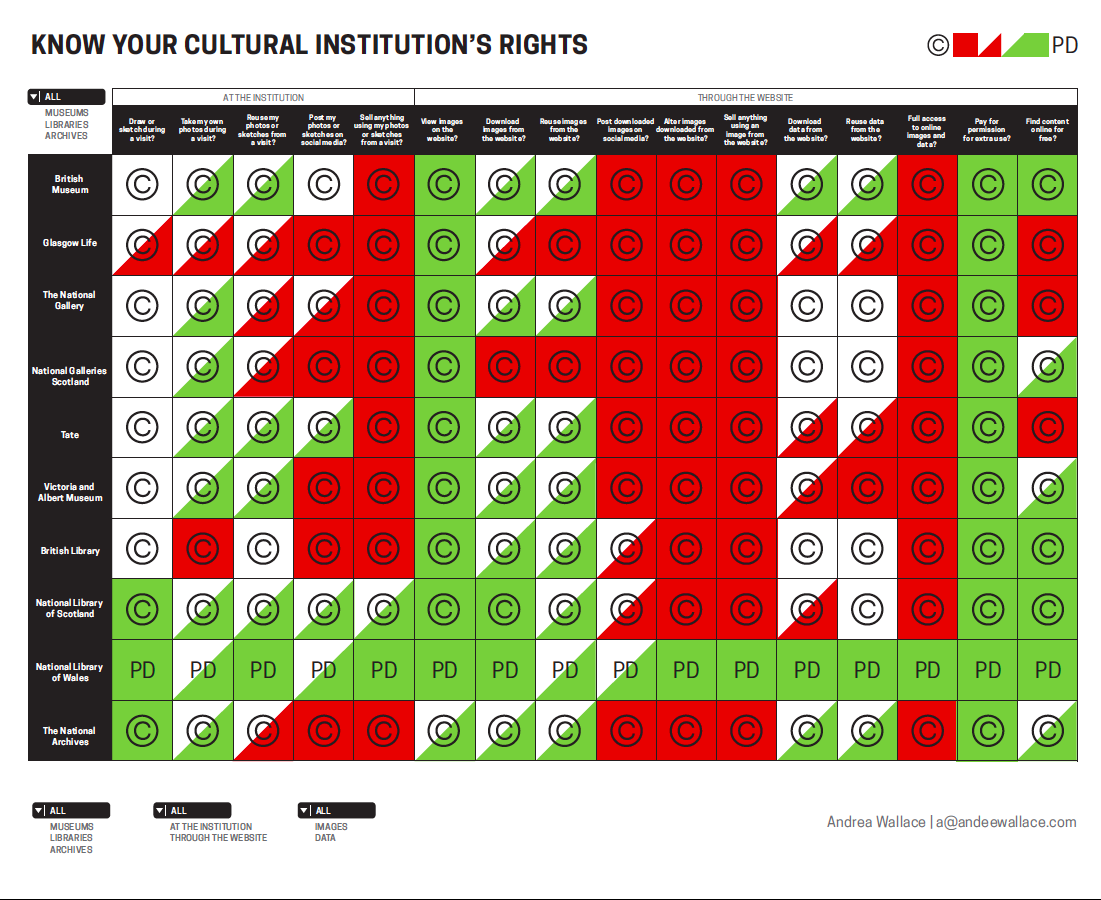
The idea is that the chart will be interactive. As users move their mouse over the chart’s squares, a box will pop up containing the cultural institution’s specific terms for that column.
In addition, the metaLAB team was ready and able to provide support for drafting our prototypes. As a designer who is usually the go-to person for this kind of thing for friends and family, it’s so nice when someone else helps by taking the reins—and especially for something as important as the logo.
Marshall Lambert, metaLAB designer, came up with this killer concept and design for a logo:
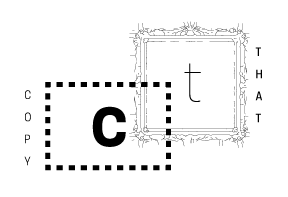
I spent that second week designing the pages and the site’s functionality in prototype form. I pitched Copy That on the final day and got spectacular feedback from an ideal audience.
So now what? We’ll see. This area is changing so quickly, is a website the best way to go? Still thinking this through…
And what about the rest of the projects? I expect great things to come.
Beautiful Data II Projects
Touch and Collect: Francesca Bacci (Università degli Studi di Trento) investigated a new museum experience engaging tactile beads of replicated materials in artworks. Visitors collect beads throughout the galleries and return them to a collection point that reads the beads’ information. An interactive display brings up images of the works associated with the beads and allows the visitor to “interrogate the museum database using the beads as query lines.”
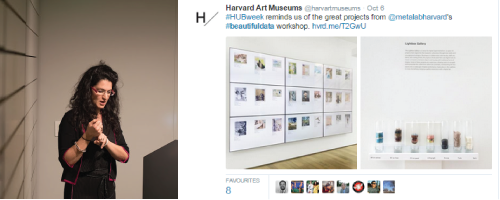
Photo credits: Harvard metaLAB team and Harvard Art Museums
The Qualitative/Quantitative Duality: A Humanities Provocation: Matthew Lincoln (University of Maryland) and Nuria Rodriguez Ortega (Universidad de Málaga) presented a website exploring the dualities of qualitative and quantitative research. Using their own research, Matthew and Nuria developed case studies into interactive visualizations that dilute the traditional assumptions which form the boundary between quantitative and qualitative characteristics.
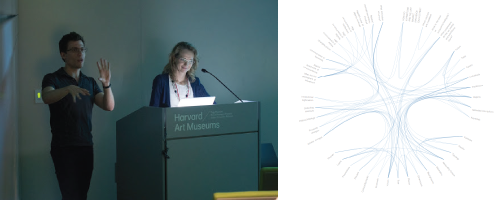
Photo credits: Harvard metaLAB team and Matthew Lincoln
Code from Corbu: Jackie Antig (Experience Design), Robin Clark (SFMOMA), Bethany Johns (Rhode Island School of Design), Jared McCormick (Harvard), Ainslee Meredith (The Wheeler Centre), and Megan Struder (City College of New York) designed a site-responsive installation in the Carpenter Center, where much of the workshop was held. The installation presents six collections based on conjunctions between four of the buildings’ architectural points and text, audio, video, and still image fragments from the collection. As a visitor passes through one of the building’s “trigger points”, an algorithm randomly assigns and displays one of the visual conjunctions to the space.
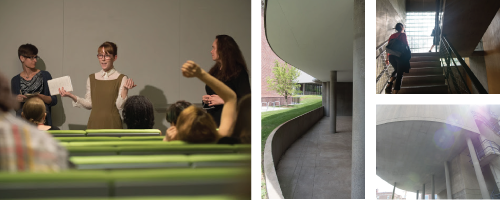
Photo credits: Harvard metaLAB team
d: Gabby Resch (University of Toronto), Jon Frey (Michigan State University), Jill Sterrett (SFMOMA), and Anna Santi built an apparatus encouraging visitors to engage with collections by prompting them to “annotate” art objects. The apparatus includes a projector, transparent sheets of artworks, and a series of symbolic and verbal prompts provoking playful and communal interactions. The project both challenges what users experience in relative isolation and digital interaction and “encourages alternative modes of participation with museums.”
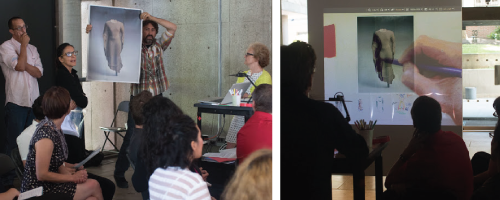
Photo credits: Harvard metaLABteam
Linked Open Data: Putting it to Use: Rachel Faust (SFMOMA), Elizabeth Neely (The Harwood Museum of Art), and David Smith (Asia Art Archive) developed a project examining available Linked Open Data end points, query, and representation issues. Since making meaningful use of LOD often requires a level of technical knowledge most researchers lack, the project presented their own exploration of these issues and proposed accessible entry points for researchers who use LOD in their work.
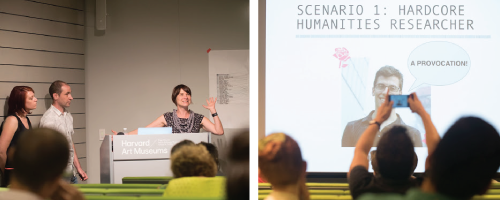
Photo credits: Harvard metaLAB team
Playing the Race Card: Marya McQuirter (Smithsonian Institution, National Museum of African American History & Culture) explored how race is revealed in, or is absent from, a museum’s metadata. The project provides a set of racial cards for Harvard/Art Museums visitors to assign to objects within and at the museum’s perimeter. These cards enable visitors to “create that metadata by exploring and exposing the absences and excesses of race with the museums”, transforming a practice usually seen as negative and accusatory into a productive and performative act.
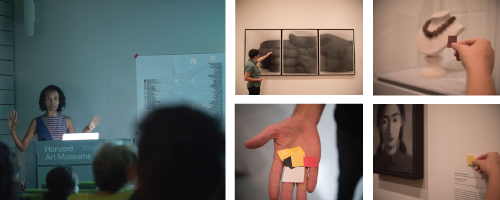
Photo credits: Harvard metaLAB team
Omg Cats: Owen Mundy (Florida State University), who launched I Know Where Your Cat Lives in 2014, returned to the data he collected for that website to explore questions like “what isolated and wonderfully weird groups of tags and phrases exist?” and “what subgroups are there?”. Owen has big plans for another data + cat user platform, so stay tuned for how he develops this project (spoiler: it’s exciting). Read Owen’s blog post about his experience.
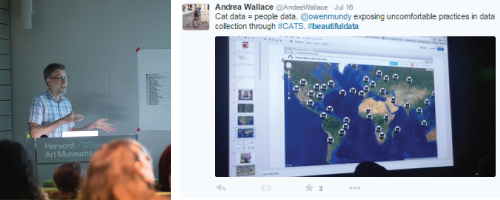
Photo credits: Harvard metaLAB team
What Do You Want?: Anne Luther (Central Saint Martins College of Art and Design) presented an experiment to exhibit the entire Harvard/Art Museums Collection for non-humans. Naturally, the first question you would ask yourself is what do non-humans want? Anne took this investigation further by engaging in and thoroughly documenting the process of directly asking a non-human this question.
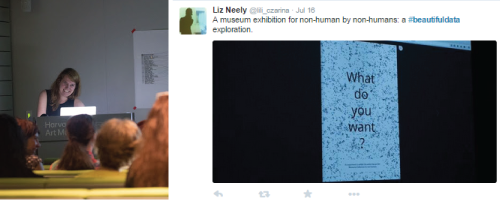
Photo credits: Harvard metaLAB team and Liz Neely
Let Me Think About This For A Second: Nikita Braguinski (Humboldt Universität zu Berlin) transformed the Harvard/Art Museums Lightbox gallery into an installation showcasing a (very entertaining) dialogue between computers. Two screens faced each other, one of which displayed image data from the Harvard/Art Museums collection in a way normally inaccessible to a human observer. The facing screen offered commentary, narrated by the computer itself, communicating its opinions and critique of the artworks displayed.
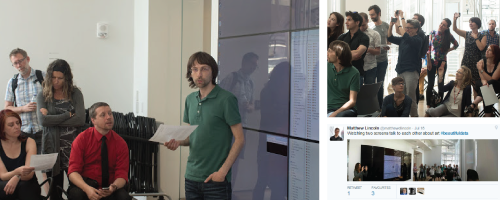
Photo credits: Harvard metaLAB team and Matthew Lincoln
Contextual Engagement: Telling the Rich Stories Inside King Tutankhamen’s Tomb: Negm Morshed (Grand Egyptian Museum) investigated a way to reclaim the metadata lost when the tomb of King Tutankhamen was “discovered” and its objects were removed. The project explored how to bring funerary objects to life to give visitors “the fullest possible account of context, materiality, and contested meanings in the New Kingdom, the Edwardian era of the tomb’s ‘discovery,’ and contemporary Egypt.”
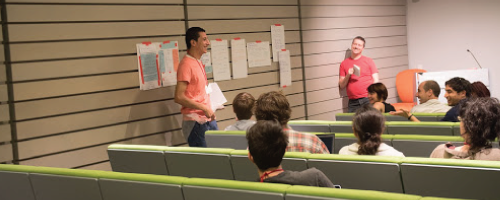
Photo credits: Harvard metaLAB team
